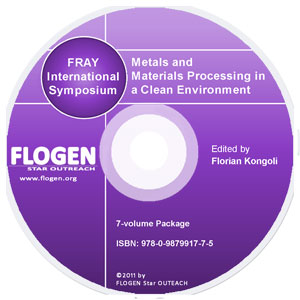
CD shopping page |
2011-Sustainable Industrial Processing Summit
|
| Editors: | Florian K |
| Publisher: | Flogen Star OUTREACH |
| Publication Year: | 2012 |
| Pages: | 646 pages |
| ISBN: | 978-0-9879917-6-8 |
| ISSN: | 2291-1227 (Metals and Materials Processing in a Clean Environment Series) |
Low Temperature Nanostructured Titania-based Compounds: Controlling Physical And Chemical Properties By Sol-gel Processing Parameters
Mohammad Reza Mohammadi1; Derek Fray2;1SHARIF UNIVERSITY OF TECHNOLOGY, Tehran, Iran; 2UNIVERSITY OF CAMBRIDGE, Cambridge, United Kingdom;
Type of Paper: Keynote
Id Paper: 411
Topic: 9
Abstract:
Part I: Nanocrystalline titanium dioxide (TiO2) and nanostructured titania-based compounds with high specific surface area have a widespread range of new applications in various industries. These materials can be obtained by different wet chemistry. In particular, sol-gel techniques offer important advantages due to a low cost simple synthetic route, excellent compositional control, feasibility of producing thin films on large and complex shapes and, the most significant one, low crystallisation temperature. In the present work, an aqueous particulate sol-gel route (an environmentally friendly processing) is introduced for preparation of these compounds such as pure TiO2, TiO2-Ga2O3, TiO2-Er2O3, TiO2-Ta2O5, TiO2-CeO2, TiO2-ZrO2, TiO2-Fe2O3, NiTiO3, CdTiO3, BaTiO3, Li2TiO3, ZnTiO3, SrTiO3, barium strontium titanates and neodymium titanates. The present method is capable to tailor the crystal structure, phase composition, microstructure, crystallite size, specific surface area, packing and ordering of the products by controlling the processing parameters. It was also shown that, TiO2 nanorods can be grown into the track-etched polycarbonate membrane by a combination of this sol-gel process and electrophoretic deposition method (i.e, sol-electrophoretic method). Some of these nanomaterials were studied for gas sensing application and exhibited a remarkable response towards low concentrations of CO and NO2 gases at low operating temperature.Part II: Nanostructured II–VI semiconducting materials, including CdS, CdTe and CdSe have received great research attention because of their unique optical and electronic properties as well as their wide technological applications in solar cells. It is known that the crystal structure, phase composition and morphology of these compounds have great influence on their optical and electronic properties. In the present work, tailoring of morphology and crystal structure of these compounds by controlling solvothermal/hydrothermal processing parameters such as nature of solvent and precursor, surfactant, reaction temperature and process time is discussed. These compounds were prepared in the forms of nanoparticles, nanowires, nanorods and tetrapod crystals and were studied for solar cell application.